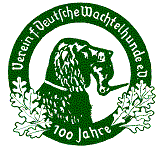|
The following is a tranlation of a pamphlet provided by the German Wachtelhund Association to each purchaser of a Wachtelhund pup. This information is particularly important in Germany because people wishing to breed their Wachtelhunds must receive prior appoval if they want the offspring registered with the association. The dogs must pass minimum accepted standards before approval is granted. The following outlines the standards. Obviously the Germans train their dogs to a higher standard and a greater variety of tasks to fit their style of hinting. This is an indication of the Wachtelhund and potential of all versatile breeds.
There is a fairy-tale story of how hunters or even dog fanciers come upon a Wachtelhund. Commonly it is after seeing a well managed, efficient Wachtelhund work which makes a hunter desire a Wachtelhund as a hunting companion. Sometimes the desire is awakened upon reading an article in a hunting newspaper or magazine. Or a visit to a German-Dog-Association sponsored field trail event for blood trailing, during a demonstration by a working Wachtelhund, can be decisive enough to lead to a purchase of a Wachtelhund. Also those who have read the book, "Golden Dogs," by Rudolf Friess will desire a closer look at the Wachtelhund. As well as hunters who have read the "Magical Team," by Dr. Hopp.
Nowadays the different books on pedigree breed dogs more or less aptly described the Wachtelhund and frequently the German-Dog-Association (VDH) and its organization for German Wachtelhund. So we need no advertisement for our dog, the Wachtelhund. Especially since the supply of puppies in Europe have barely satisfied the demand. And increase breeding was never desired in the German-Wachtelhund-Association (VDW). "Performance-breeding" from the very beginning was the most important breeding principle.
The German Wachtelhund [DW] is a small, versatile dog bred for a number of different hunting tasks. Though not all hunters are in a position requiring all hunting tasks or in a situation to manage such an enthusiastic hunting dog. If however, the purchaser has actually decided on a Wachtelhund they should be shown the organized nature of the VDW field trial tests and referred to sources for detailed issues.
The Hunting Tasks:
We (VDW) breed German Wachtelhunds for the hunting tasks for the hunter in woodland hunting and water work. To make a practical hunting companion and retriever. From commencement of the breeding, it came under the magical instruction of Rudolf Friess on field work, searching and the point.
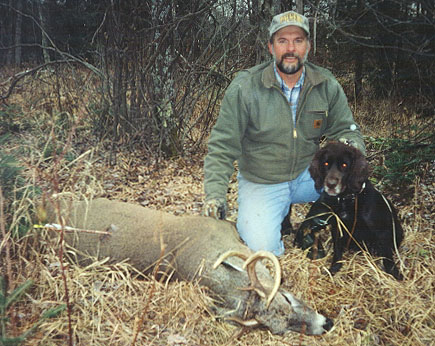
Anabella Blood Trailed a Wounded Deer
Nevertheless, the Wachtelhund is a versatile hunting dog, whose functions are to work before the gunshot, in searching and flushing from thick cover, and retrieving feathered and fur game, as well as blood trailing cloven hoofed game. These tasks are in the field trial regulations of the VDW for versatile performance tests. In the regulations for the German Association Blood Trailing performance tests, and the guidelines of the German Versatile Hunting Dog Association for the recognition of faithful retrieving and in the regulations of the Versatile Dog Association for the retriever field trials.
Traits of the Wachtelhund:
The R. F. said, "the Wachtelhund is no dog for the Sunday-hunter." The Wachtelhund employs the errors of his Master's thoughtless training, and through its hunting passion is a difficult dog to control with out proper training and discipline. This can cause the owner as much aggravation over the boisterous hunting of a undisciplined dog, as delight by his spirit and lively nature. However, harsh training and education should not be used as these are intelligent and sensitive dogs.
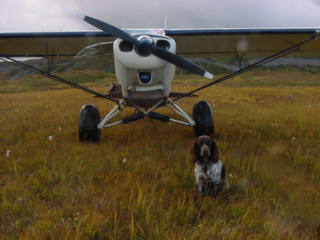
August
Very early into the breeding the breed developed into two distinct lines, based on diverse hunting standards. They were the solid brown and the brown-white (brindle) breed. The first line out of breeders was the solid brown which was consistently quieter (in its hunting. and larger bodied, with less trailing ability, but a lot easier to manage. The brown-white brindle mix came about twenty years later in the breeding, was more spirited and slender bodied, and proved themselves during blood trailing as particularly persistent.
After World War II both lines were inter-bred. The war damaged the entire breeding stock in the Eastern regions. The effects of the war on the breed resulted in many solid brown bitches no longer having the track-tone ability (barking or giving tongue while trailing) of the Wachtelhund. Through the mating with brown-white-brindled male, this shortcoming was soon remedied. However, as a result of the multiple indiscriminate brindle mating the individual traits of each line were largely covered over and today, the attributes to each line can no longer be clearly distinguished.
The Distance Hunter:
In hunting areas, the traditional hare-harvesting has been with the single hunting dog that could follow (trail) the hare for a long distance, until it circled and returned to the vicinity of its lair where it could be shot. This area is known as the "hare-cross-way". This "distant-trailing" characteristic introduced the distance-hunter line to the breed. Dogs with this characteristic were particularly more track-willing, with a sensitive nose and excellent trailing capability; and are preserved by identification, as a breed reserved for the day, if and when Wachtelhunds lose their trailing capability.
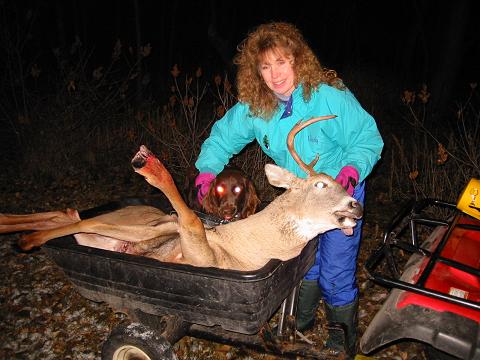
Autumn Blood Trailed a Wounded Deer for Cindy
The designation, "distance-hunter," by itself can be misleading; but is best described by Rudolf Friess, in that "the true distance-hunter" will follow the hare's scent through the distant circle until it returns to its beginning area. In contrast to the changer dog that will follow the hare's trail, but is quick switch onto fresher tracks or scents as it comes across them, hour-after-hour indulging its passion. (It is not uncommon for hare to run several or more miles before turning.
The "distance hunters" should not be allowed to chase healthy deer. This is frowned upon as opposed to blood trailing wounded deer which is a conservation measure to retrieve wounded game.
Breeding and Training:
Not only are the inherited wolf like instincts crucial for the subsequent suitability of a dog during its hunting application, but the groundwork is created with the breeder, when the dog attaches itself to this person. When the breeder only rarely spends time with the pups and allows the bitch to raise the pups alone, the desired "hunter-dog" relationship is placed into question. (Dogs are pack animals and look to the Alpha dog for leadership. This should be the owner or hunter).
Shy behavior of dogs and later shyness to its environment or timidness to strangers is most likely manifested out of wanting or lacking contact to the breeder and owner during it early pup ages. The pup should trust the breeder and owner. Then the dog will behold the person for another dog, although with different scent. Behavior researchers through the recent years have publicized and reinforced the need for young dogs to engaged in new experiences with its owner.
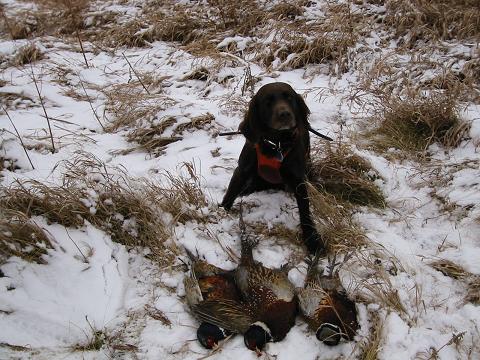
Willow Pheasant Hunting
A puppy at the ages of seven through twelve weeks has the exceptional ability to process many new experiences. Experiences during this period form its adult behavior. Therefore, the puppy should have the opportunity to get to know his environment, especially after the purchase, and preferably through constant contact with its handler. Many behavior manners of the young dog are formed in this period, for example the behavior to work on the long leash during training to follow the scent of a dragged item or piece of game. (Training the dog to concentrate on a scent trail by keeping it on a long leash while it follows a specific trail. If it leaves the scent trail it can be immediately brought back onto the trail with the leash).
At five to six months many Wachtelhunds exhibit their hunting abilities. If the dogs frequently come upon deer, they will quickly identify the deer scent and learn to trail deer, the deer scent being much easier to follow, in contrast to the difficult hare-scent. (Obviously if you want to train your Wachtelhund to hunt only birds, and possibly rabbits, you should not allow it to hunt deer and/or rabbits during its formative ages). Also hunting rabbits is not conducive to its development. (The rabbits in Europe live in colonies, having many borrows and rarely move more than several yards from a borrow. Allowing Wachtelhunds to chase them does not develop their concentration to follow a long trail).
Therefore it is important the dog, so far as possible, should not be allowed total freedom. The leash is the most important training aid. Not only the walking leash, but the long check cord should be constantly used. The learning to follow a hare trail on the long leash, as best as the hares movement was observed, educates the dog to steady and focused work.
Preparation to the Youth-Examination (JP):
Upon the youth-examination, normally owners of dogs up to the age of 15 months are notified for assessment of the dog's hunting aptitudes. Aptitudes in nose, trailing-tone (barking while trailing), willingness to trail and ability to follow the trails scent will be observed for trailing of unseen hares. These aptitudes are to awaken and to promote the following of the hares scent through independent work, as well as on the long leash. Also the ability of the dog to find game in thickets through intensive searching is an essential aptitude of the Wachtelhund.
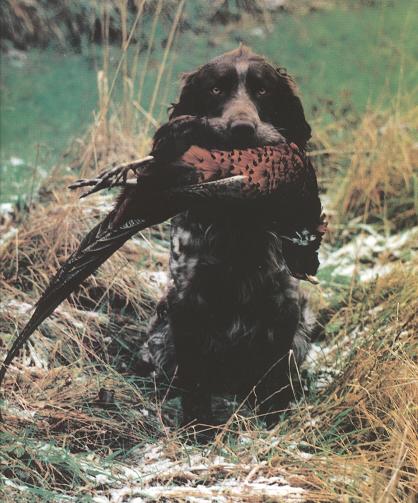
Retrieved Pheasant
The dog requires a variety of opportunities to develop its aptitudes, preferably in different hunting areas with diverse terrain and under impeded conditions. When a young dog never receives an opportunity to look for game in a thicket, it will demonstrate its lack of searching ability and desire during the trial of the searching ability test. When possible, one should allow the young dog to search where hares and feathered game are found, however, areas holding deer should be outright avoided.
The water-joy is an innate Wachtelhund quality. Normally it is not difficult to lead the young doe to swimming. The so called, "education-fishing rod" can be a valuable help. Also a piece of wood to swing an attached pigeon, offers a sufficient incentive to lead the young dog into the water. However during field trial testing the dog is sent without aids into the water.
The late retrieving training will not harm it, when the aptitude to retrieving is awaken in a playful manner, especially as the actual retrieving training should begin around the age of twelve months. (North American standards begin training as soon as the permanent teeth are in).
Gun-shyness is also tested during the youth-examination. The dog will remain undisturbed to gunshots fired by its owner, generally after the trial of the searching ability test. The young dog should have already gotten to know the bang of the shotgun in the course of his education. Attempts to take the dog to the firing line on a firing range or through extensive use of the blank pistol to accustom the dog to gun shots, could easily cause gun shyness.
Dogs that exhibit sound sensitiveness normally become accustomed to gunshots, at the latest in the first hunt season when they can retrieve a shot animal.
The obedience of the dog is demonstrated by its joyful returning after it has finished the chase. However solely entering into the chase does not make it a hunting dog (additional training and discipline make a hunting dog). Also when they become free, they must be greeted kindly without anger, "hand-shy" dogs are not born. but educated.
The Suitability-Examination (EP):
The suitability examination also determines the development of the dog's hunting aptitudes. At the same time however the successful training and the dog are tested.
The field trial events include the subjects of the hunting suitability testing and proof of the hunting usefulness demanded by German State and Federal laws. The EP can be broadened to include specific State required tests (e.g., German law requires all hunting lease holders to have dogs capable of recovering wounded game).
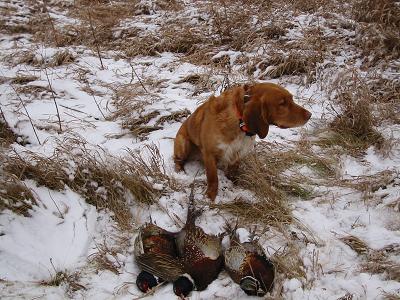
Arno Pheasant Hunting
Trial events therefore are developed in the subjects of retrieving feathered and fur game from a trail (man made by dragging a dead animal). The dog is tested on a 200 meters long hare trail or an optional 500 meters long rabbit trail. Included with the hair game test through the forest, is the feather game trail (150 meters) through the fields.
Also searching in thickets for game is included in the field trial events. Water work normally includes the searching for ducks, as well as, retrieving killed ducks out of deep water and marshes.
The blood trailing is an elective event, but can added to the suitability examination in accordance with the appropriate State / Federal hunting agencies to prove hunting usefulness.
The Versatile Examination (GP):
The dog shall be put through the versatile field test permitting it demonstrated aptitudes in the (JP) or (EP) field testing events. The GP demonstrates aptitudes in the subjects nose, track-tone, tracking ability and steadiness.
An especially difficult subject has proven to be the versatile field testing for blood trailing. Only careful and comprehensive initial training on the overnight scent can lead the Wachtelhund to the successful completion of the versatile field testing. For many dogs, hot-headedness during the initial training will spoil talented dogs to working on the long leash. If a trainer understands his dog, he'll prepare at the end of the artificial trail a special success experience, to create an incentive for the dog to get to the end of the trail. It will accentuate the desire to follow a trail. The trainer must find out what causes the strongest success experience in his dog, whether it is the filled feed bowl, or especially loved training toy or a piece of game meat for the dog.
During the versatile testing many dogs fail the hare trailing and retrieving test. This also requires careful initial training and working practice. Weight training is absolutely necessary for small dogs. Do not open up game to entice the dogs to retrieve them.
Fox-retrieving, as well as [Totverbellen] (Death Howler) (This is a natural instinct to bark or howl after finding dead (big) game and remaining with it until the hunter comes, dogs cannot be trained to do this, they either have it instinctively or do not) or [Totverweisen] (Death Informer) (dogs are trained to grab a piece of leather hanging from their collar when they find dead (big) game and return to their handler, holding the leather signifies it found the dead game. These are elective tests at the versatile field trails.
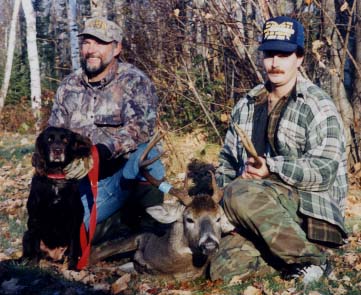
Anabella and Gary Find Deer for Neighbor
Special value is placed on close hunting during the game searching test. At the same time, the Stoberhund is independent and wide searching; preferably chases, circles, bringing game back to the handler; it does not hunt cloven hoofed game by itself, especially deer, which the handler stops it by a blow from his whistle. (Stoberhund is a German classification of hunting dogs with Wachtelhund being the only breed in this classification. The other classifications being pointers, retrievers, flushers, hounds, and earth dogs. The word Stober means to rummage or rummage about. I have substituted "searching" in its place through out this document. Stoberhunds (Wachtelhunds) hunt with both a high nose, when game is close or for birds, using air scent as a normal bird dog, and with a low nose for foot or ground scent when tracking as a hound.)
Water work testing includes searching in deep marsh water for downed ducks and retrieving them.
The versatile dog test also demands flushing in front of the shotgun and steadiness to the shot. Obedience is one of the most important tests. At the shot, the dog must not leave its place.
During the versatile examination the Wachtelhund shall demonstrate that it can perform all the standards of the forest-versatile-hunting dog. As a [Stoberhund] free to quarter and search, it will find game and loudly chase it before the hunter. As a flushing dog obedient to the shot while flushing from thick undergrowth. After the shot it can be placed on the long leash and follow a 600 step, overnight scent to locate shot game. On the drag trial it will proved its ability to retrieve the hare to his handler, also to go into thick covered terrain to retrieve feather-game. High standards are placed on water work, for this concerns the water joyful Wachtelhund with its special passion for water.
A talented and good trained Wachtelhund is desired, so that in the hunting situation, as a versatile hunting dog it can perform all of the hunting tasks that the hunter demands from it, with exception of pure pointing field work.
Examinations of the Versatile Hunting Dog Association:
Many Wachtelhunds are successfully entered into the association blood trailing testing. Standards of this testing, to follow a 20 hour old blood scent of a 1000 meters, are essentially no higher than the standards of the versatile field trial events.
Far more Wachtelhunds have successfully completed this event acquiring the [Vbr] and are entered into the versatile hunting dog line book. The [Vbr] is regarded as one of the highest awards, a dog can achieve. The requirement, to track and find wounded game and retrieve it to its handler, should be placed on each dog recognized as a versatile dog.

Autumn
A dog is a faithful retriever when it finds game and retrieves it to his handler as demonstrated in early retrieving tests on the hare, on the pheasant and on the fox. Today the Association utilizes the fox for the faithful retriever test, since it is the game dogs least like to retrieve. However, most Wachtelhunds retrieve the fox, and so more Wachtelhunds attend the advertised faithful retriever trials from the versatile hunting dog association.
During the hunt when dog comes upon a predator or non-game predators and kills it, the dog is identified as a Wurger (Predator/Varmint Killer) and certified (by other hunters in the dogs ability to kill predators and varmints and recorded so on their pedigree).
The determinations and testing-orders for VSw, Vbr and Btr, as well as for the hard proof, of Predator/Varmint Killer is stipulated by the versatile hunting dog association. Hunting dogs that practice reliable blood trailing work, receive the performance sign (:) (the blood trailing-points) for natural blood trailing work, for dogs that work only in deer areas, the points are put in brackets (:). The last application is the reliable searching for wild boar (pigs) which is especially important. Performance sign "S" is given for successful wild boar hunters.
All performance proof obtained during actual hunting (distance hunter, dispatching predators, natural blood trailing and work on wild boar) is submitted to the appropriate Chairman, State Breeding Office.
Performance Signs:
The Association for German Wachtelhunds earmark its dogs through performance-signs, that are acquired at field trial events or are awarded in practical hunting conditions for dispatching predators, distance-hunter, wild boar hunter and successful blood trailing works.
| Earmark | Meaning |
|---|
| ASSr. | Show-winners |
| PSSr. | Field trial winners |
| DW Sgr. | German Wachtelhund-winner |
| Vbr | Retrieving from a natural wounded trail |
| Btr | Retrieving a fox |
| \ | Barks loudly While Trailing |
| \\ | Distance hunter |
| / | Predator/Varmint Killer |
| - | Barks When it Finds Dead (Big) Game |
| ! | Returns to Handler with Pouch in Mouth After Finding Dead (Big) Game |
| S | Proof of the successful employment at wild boar hunting |
| : and (:) | Blood trailing work on wounded cloven hoofed game |
| Sw I to III | Association-blooding trailing test on 20 hour old scent |
| Sw/ I to III | Association-blood trailing test on 40 hour old scent |
The underlined number behind the enrollment-number is the dog's standing in versatile field trial testing which is placed into the Versatile Hunting Dog Book. Example:
Xilla Vom Hagerwald 378/ 83, 1252.
Breeding-order:
We breed Wachtelhunds, as a useful hunting dog to aid the hunter. However the agreeable nature of the most Wachtelhunds also seduces many non-hunters, to acquire the Wachtelhund as dear house-companion. Therefore, the association has implemented a very precise breeding order.
They might be bred only with other dogs, that have been entered into the Wachtelhund pedigree breeding book, after having proved their good hunting disposition and were assessed with at least a value of "good."
A dog will be authorized to the breed which shows no faults; e.g., tooth mistakes, eyelid mistakes, skin disease or testicle faults in male dogs. Also natures shortcomings like gun shyness will rule dogs out of the breeding.
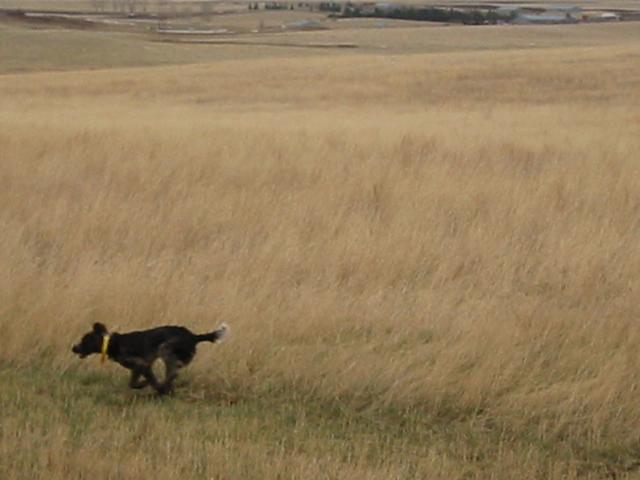
Lara Working Pheasants
In the early united years immediately after the VDW was formed in 1903, hip dysplasia well known in dogs, also occurred in the Wachtelhund. In the breeders attempt to control hip dysplasia, the Association established specially detailed rules for breeding. The German Association provides breeding approval for applicants based on X-ray evaluations of the breeding parents.
The X-rays of the dog, on its back with the legs stretched out, with the radiologist certification the dog is without hip problems are submitted together with the genealogical tree of the dogs to the Breeding Book Office for breeding approval.
Only dogs that come from suitable breeding parents, receive a genealogical tree. Pups from parents not fulfilling all of the breeding order specifications, receive only identification cards with remarks giving preconditions and requirements for these dogs to receive a genealogical tree.
Conceivably a banned breeder will enter a dog for genealogical tree. Banned breeders will have remarks entered into the breeding book disallowing further breeding with the result, that descendants of such a dog not registered in the Breeding book of the VDW will not be recognized as a German Wachtelhund.
Notifications at the breeding-book-office:
Occasionally illnesses and faults appear in Wachtelhunds, breeders are to notify the Breeding book office. Only through complete information of corresponding breeders can the breeding association take measures to prevent the spread of undesirable traits in the breed.
All breeding questions are addressed to the association breeding committee in cooperation with appropriate state breeding committees.
| 